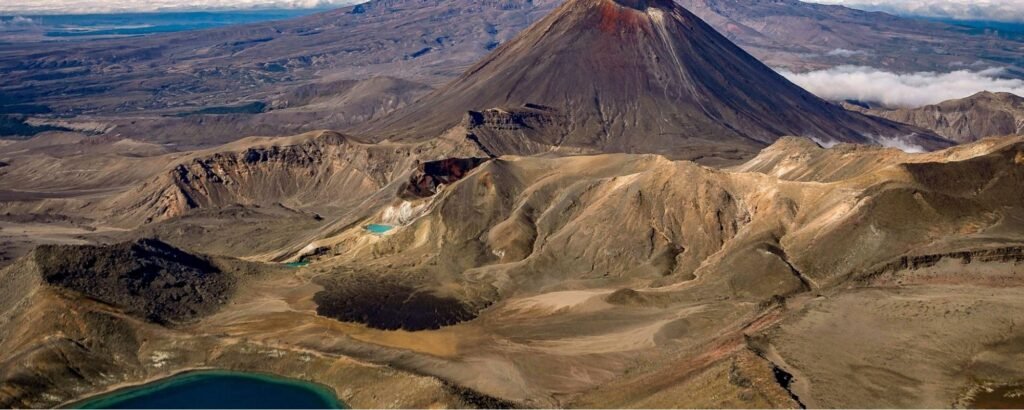
We live in the heart of it, surrounded by active volcanoes and perched right on the edge of the Pacific tectonic plate. Over the years we’ve felt the earth rumble beneath our feet, experienced a few decent earthquakes and were witness to the eruption from Mount Ruapehu.
And yet, we wouldn’t be anywhere else.
Like most Kiwis, we’re aware of the risks, but we don’t let them rule our lives. It’s just part of living in a country shaped by nature — raw, powerful and breathtaking. If you come knowing about these natural hazards, you can still experience the best of Aotearoa with confidence and care.
What Makes This Topic So Important?
Aotearoa – New Zealand might be one of the safest countries in the world in terms of crime, but the natural environment can throw a curveball at any time. Earthquakes, volcanic zones, fast-changing weather and remote locations all bring risks worth knowing about before you hit the trail, coast or road.
Understanding the Risks
Sudden Weather Changes

In the mountains or remote valleys, the weather can change in minutes. You could start a walk in sunshine and finish soaked and freezing.
- Always check the MetService forecast before heading out.
- Pack layers and waterproof gear — even in summer.
- Avoid river crossings after heavy rain — flash flooding is real.
Remote Hiking & Tramping Safety
Part of what makes Aotearoa magical is how remote some places are. But with that comes limited reception and long waits for help if something goes wrong.
- Let someone know your plans. Use the AdventureSmart trip intentions form or text 7233 (SAFE) with your route.
- We like to use Plan My Walk
- Carry a Personal Locator Beacon (PLB) in off-grid areas.
- Book the Great Walks well in advance — they’re not a show-up-and-go experience.
Coastal Hazards
The coastline can be wild especially on the West Coast or far north. Rip currents, big swells, and hidden rocks can turn things fast.
- Swim at patrolled beaches like Piha, Mount Maunganui, or Sumner.
- Check live conditions via Surf Life Saving NZ.
- Never turn your back on the waves.
Earthquakes and Volcanic Activity
Aotearoa – New Zealand sits right on the Pacific Ring of Fire, which means small tremors are common and volcanic zones are part of the landscape especially around Rotorua, Taupō, and Tongariro.
- Download the GeoNet app to stay updated on any activity.
- Stick to marked tracks in geothermal areas — those signs are there for a reason.
- Learn basic earthquake safety: drop, cover, hold on.
A Powerful Reminder-Walking with Awareness, Respect and Gratitude
The 2019 eruption of Whakaari / White Island took 22 lives and left many more injured. It shook the nation and brought renewed focus to how we assess risk in Aotearoa – New Zealand’s more extreme environments.
Natural events like this aren’t new. The 2011 Ōtautahi / Christchurch earthquake devastated lives and infrastructure, and the 2016 Kaikōura earthquake cut off entire communities. These moments stay with us — not just because of the destruction, but because of the resilience they revealed.
If you ever feel unsure about a tour or outdoor activity, ask questions. If something doesn’t sit right — don’t go. It’s not weakness to back out. In Aotearoa, we believe in reading the signs.
Trust the journey – trust your tohu.
Helpful Tools to Stay Safe
- GeoNet App – For quake and volcano alerts
- MetService – Regional and mountain weather forecasts
- AllTrails – Great for route planning
- Plan My Walk – Route planning, weather forecasts, track conditions
- 7233 (SAFE) – Free text service for trip intentions
- AdventureSmart.nz – Excellent pre-trip checklists and advice
- Surf Life Saving NZ – Up-to-date beach safety info
🌱 A Final Note – Keep Perspective
Please don’t let any of this stop you from experiencing the beauty of Aotearoa – New Zealand. Every country has its own natural risks, and most travellers enjoy their journeys here without incident.
This guide isn’t meant to scare you — it’s simply here to raise awareness and help you stay informed. The likelihood of a major natural event is slim, but not impossible. Being aware, not afraid, is the key to travelling well.
Come with respect for the land and those who live here — and you’ll be welcomed with open arms.
Ko te whenua te waiu mō ngā uri whakatipu
The land is the sustenance for future generations